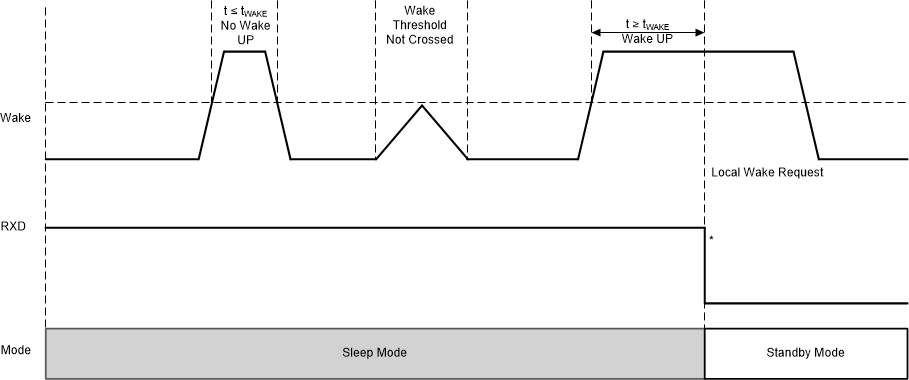SLLSF27D November 2018 – June 2022 TLIN1441-Q1
PRODUCTION DATA
- 1 Features
- 2 Applications
- 3 Description
- 4 Revision History
- 5 Description (continued)
- 6 Pin Configuration and Functions
- 7 Specifications
- 8 Parameter Measurement Information
-
9 Detailed Description
- 9.1 Overview
- 9.2 Functional Block Diagram
- 9.3
Feature Description
- 9.3.1 LIN Pin
- 9.3.2 TXD (Transmit Input)
- 9.3.3 RXD (Receive Output)
- 9.3.4 WAKE (High Voltage Local Wake Up Input)
- 9.3.5 WDT/CLK (Pin Programmable Watchdog Delay Input/SPI Clock)
- 9.3.6 WDI/SDI (Watchdog Timer Input/SPI Serial Data In)
- 9.3.7 PIN/nCS (Pin Watchdog Select/SPI Chip Select)
- 9.3.8 LIMP (LIMP Home output – High Voltage Open Drain Output)
- 9.3.9 nWDR/SDO (Watchdog Timeout Reset Output/SPI Serial Data Out)
- 9.3.10 VSUP (Supply Voltage)
- 9.3.11 GND (Ground)
- 9.3.12 EN/nINT (Enable Input/Interrupt Output in SPI Mode)
- 9.3.13 nRST/nWDR (Reset Output/Watchdog Timeout Reset Output)
- 9.3.14 VCC (Supply Output)
- 9.3.15 Protection Features
- 9.4 Device Functional Modes
- 9.5 Programming
- 9.6 Registers
- 10Application and Implementation
- 11Power Supply Recommendations
- 12Layout
- 13Device and Documentation Support
- 14Mechanical, Packaging, and Orderable Information
Package Options
Mechanical Data (Package|Pins)
- DMT|14
Thermal pad, mechanical data (Package|Pins)
- DMT|14
Orderable Information
9.4.5.2 Local Wake Up (LWU) via WAKE Terminal
The WAKE terminal is a high voltage input terminal which can be used for local wake up (LWU) request via a voltage transition. The terminal triggers a LWU event on a high to low or low to high transition. This terminal may be used with a switch to ground or VSUP. If the terminal is not used, it should be connected to VSUP to avoid unwanted parasitic wake up.
The LWU circuitry is active in sleep mode and standby mode. If a valid LWU event occurs, the device transitions to standby mode. The LWU circuitry is not active in normal mode. To minimize system level current consumption, the internal bias voltages of the terminal follows the state on the terminal with a delay of tWAKE(MIN). A constant high level on WAKE has an internal pull up to VSUP and a constant low level on WAKE has an internal pull-down to ground. On power up, this may look like a LWU event and could be flagged as such.
 Figure 9-8 Local Wake Up (LWU) - Rising Edge
Figure 9-8 Local Wake Up (LWU) - Rising Edge Figure 9-9 Local Wake Up (LWU) - Falling Edge
Figure 9-9 Local Wake Up (LWU) - Falling Edge